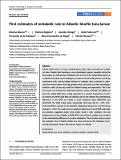Por favor, use este identificador para citar o enlazar a este item:
http://hdl.handle.net/10261/322584COMPARTIR / EXPORTAR:
 SHARE SHARE
 CORE
BASE CORE
BASE
|
|
| Visualizar otros formatos: MARC | Dublin Core | RDF | ORE | MODS | METS | DIDL | DATACITE | |

| Título: | First Estimates Of Metabolic Rate In Atlantic Bluefin Tuna Larvae |
Autor: | Blanco, Edurne; Reglero, Patricia CSIC ORCID; Ortega-García, Aurelio; Folkvord, Arild; de-la-Gándara, Fernando; Hernández-de-Rojas, Alma; Moyano, Marta | Palabras clave: | Centro Oceanográfico de Baleares Acuicultura |
Fecha de publicación: | 2020 | Editor: | John Wiley & Sons | Resumen: | Atlantic bluefin tuna is an iconic scombrid species with a high commercial and ecological value. Despite their importance, many physiological aspects, especially during the larval stages, are still unknown. Metabolic rates are one of the understudied aspects in scombrid larvae, likely due to challenges associated to larval handling before and during respirometry trials. Gaining reliable estimates of metabolic rates is essential to understand how larvae balance their high growth needs and activity and other physiological functions, which can be very useful for fisheries ecology and aquaculture. This is the first study to (a) estimate the relationship between routine metabolic rate (RMR) and larval dry weight (DW) (mass scaling exponent) at a constant temperature of 26°C, (b) measure the RMR under light and darkness and (c) test whether the interindividual differences in the RMR are related to larval nutritional status (RNA/DNA and DNA/DW). The RMR scaled nearly isometrically with body size (b = 0.99, 0.60–31.56 mg DW) in contrast to the allometric relationship observed in most fish larvae (average b = 0.87). The results show no significant differences in larval RMR under light and darkness, suggesting similar larval activity levels in both conditions. The size explained most of the variability in RMR (97%), and nutritional condition was unrelated to the interindividual differences in routine metabolism. This is the first study to report the metabolic rates of Atlantic bluefin tuna larvae and discuss the challenges of performing bioenergetic studies with early life stages of scombrids. | URI: | http://hdl.handle.net/10261/322584 | DOI: | 10.1111/jfb.14473 |
| Aparece en las colecciones: | (IEO) Artículos |
Ficheros en este ítem:
| Fichero | Descripción | Tamaño | Formato | |
|---|---|---|---|---|
| 26084.pdf | 897,79 kB | Adobe PDF |  Visualizar/Abrir |
CORE Recommender
SCOPUSTM
Citations
5
checked on 30-abr-2024
WEB OF SCIENCETM
Citations
4
checked on 28-feb-2024
Page view(s)
19
checked on 30-abr-2024
Download(s)
53
checked on 30-abr-2024
Google ScholarTM
Check
Altmetric
Altmetric
NOTA: Los ítems de Digital.CSIC están protegidos por copyright, con todos los derechos reservados, a menos que se indique lo contrario.
